Last Updated on October 28, 2020 by Laura
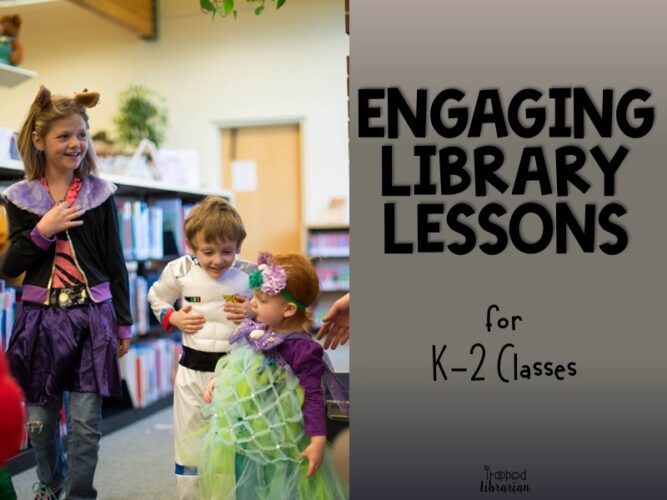
I’ve had lots of questions about how to plan engaging library lessons for K-2 classes to fill 45 – 60 minutes. This is particularly challenging during this pandemic, since we have to consider health and safety guidelines if we are learning in person. Many schools are still teaching in a remote or hybrid environment, which offers challenges as well.
This post includes affiliate links for your convenience. This means that I may receive a small commission from purchases at no additional charge to you. Thank you for your support.
The truth is, if we revisit best practices for student engagement for young learners, we will be able to plan engaging library lessons for our K-2 students without going crazy! I’d like to share a recent lesson that I used with a first and second grade combo class in a 75 minute time slot. Take a look at my sticky note lesson plan as I share my strategies with you!
Engaging Library Lessons for K-2 Include Routine
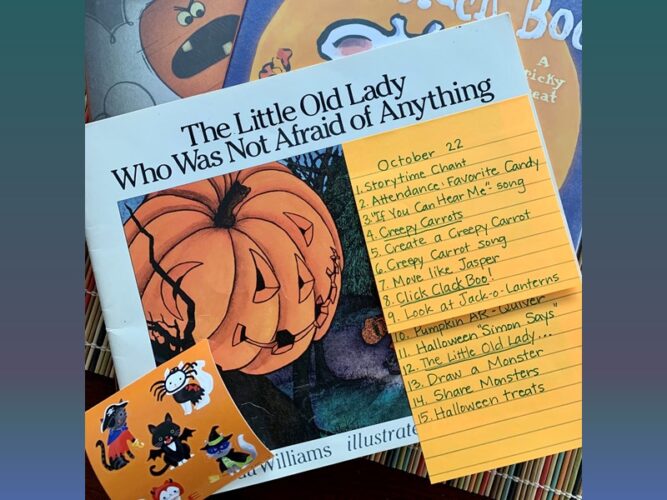
Predictable routines provide comfort and a sense of security to young children. I like to make music and movement part of our regular routine. When we start our library lessons with a storytime chant and storytime song, I get happy students eager to participate. And if I forget, I definitely get reminded! I learned a fun storytime chant and storytime song from Emily Arrow. The best thing is that they are easy to modify to fit your needs and expectations.
Variety is Key to Engaging Library Lessons for K-2
We know that our youngest students have short attention spans. This is why it’s important to plan to change activities about every 5-10 minutes. Vary your activities to include listening, moving, and creating to keep your students actively engaged.
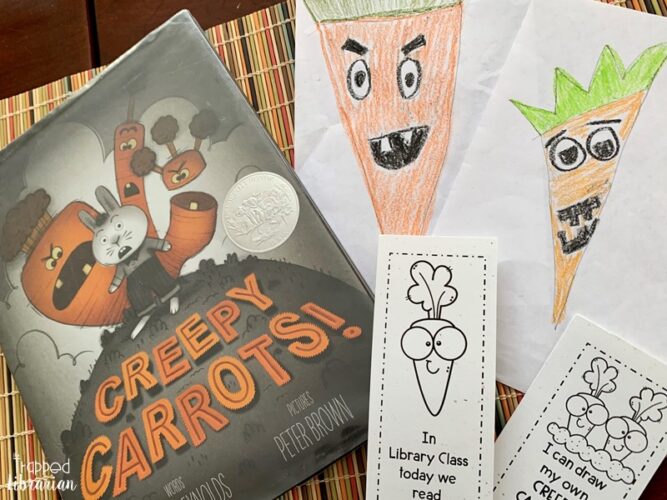
After our storytime chant and song, we were ready for a read aloud of Creepy Carrots by Aaron Reynolds and Peter Brown. The book works great for this time of year, whether or not your school celebrates Halloween. The underlying concept for our day was making inferences about feelings by observing facial expressions. As we read, we stopped to discuss the carrots’ faces, as well as Jasper Rabbit’s fun expressions. We also made predictions, stopping to notice lots of details in the illustrations. (There is also a fabulous video from the illustrator here!)
Create and Move with Your Young Students
Next, it was time to create our own creepy carrots. I gave each student a piece of white paper and asked them to think about how their carrot was feeling and to show it with a facial expression. When we were finished, we spread out around the room to share our carrots. Then it was time for a song. I used the same tune from the Halloween pumpkin song in my storytime blog post. (You can find the video here.) Only this time we sang about the creepy carrots that were created: “Four Creepy Carrots snarling, snarling – Four Creepy Carrots are ANGRY!” You can have fun with the carrots your students created by modifying this song on the spot.
After that, we moved around the room like Jasper and the carrots. (*Note: I had access to a small, empy gym, so we could still follow social distancing rules. If you are confined to a smaller space, you could play “Simon Says” with the same concepts and keep students in a more contained area.) First we hopped, then we tiptoed, then we ran.
Repeat to Extend the Engagement
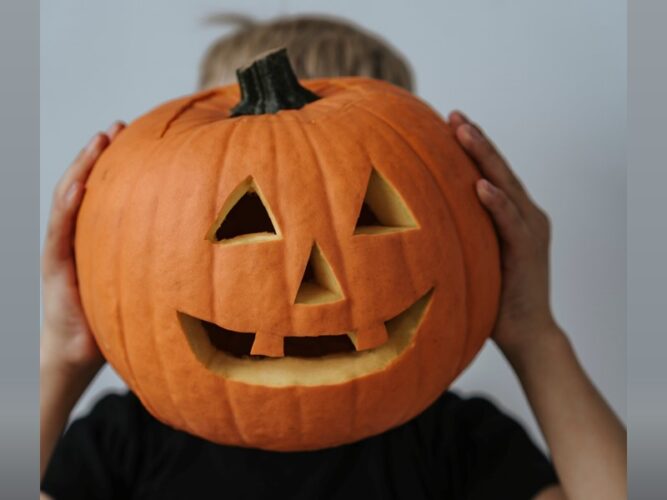
Repetition is key for engaging library lessons for K-2. So after we listened, created, sang, and moved, we were ready to repeat! The next story I shared was Click Clack Boo! by Doreen Cronin. This is a fun Halloween story for K-2 students because students can repeat the fun onomatopoeia phrases throughout the story. We extended our inferencing observations as well.
Next, I showed illustrations of jack-o-lanterns and asked the kiddos to think about what kind of jack-o-lantern face they would like to draw. We used the Quiver pumpkin coloring page and their free augmented reality app for an engaging activity. I connected my iPad to the big screen TV so each student had a chance to have the class see their creation larger than life!
Plan for More
My 75 minutes were over by this time, but I had more planned just in case. If I had time, we would have played “Halloween Simon Says,” read another Halloween book, and had a directed drawing of a monster. (Unfortunately, I had to save my monster scavenger hunt for next year because of social distancing requirements.) If you make a list of activities that alternate between listening, creating, music, and movement, you will be well prepared for an engaging library lesson for your K-2 students. Be creative, stay flexible, and have fun!
Watch my Live Video
Take a look at this video on Facebook to learn more about my lesson.
Engaging Library Lessons for K-2
If you’d like some engaging, low-prep library lessons for your kindergarten, first grade, and second grade students, I can help! This Storytime Bundle has 3 fun units that will help you guide your students through listening, creating, singing, and moving. Grab it at a 20% savings today!
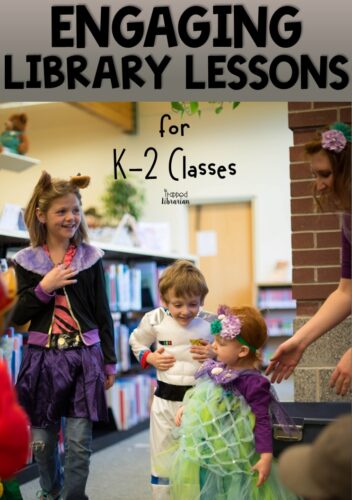
Be the light!
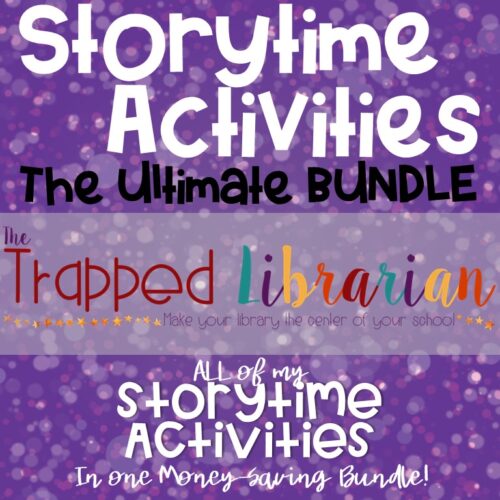

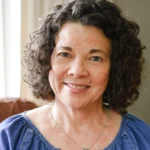

Hi Laura
Thank you so much for a detailed example of how to engage k-2 students for a 75 minute period. As someone just beginning my teacher librarian journey, I appreciate the insight and tips. I really liked how you added movement and music to your lesson plan- when I think about teacher librarian lessons, physical activity and music isn’t the first thing that comes to mind. However, it’s a good reminder that the library has evolved since I was a child in school and best practices should be integrated in all spaces. Thank you!
Hi Shannon – I agree, best practices should be followed in the library! All those things we’ve learned about engagement as teachers will help us in our lessons. When I started using music and movement with my youngest classes, I noticed a big difference. Thanks for stopping by!
Hi Laura,
Thank you for your detailed ideas on how to engage k-2 students within the library! I often think this age group is the hardest to work with. I never thought of integrating music and movement into my lessons. I think this is a great perspective and something I am looking forward to trying! It’s great that the library has began to evolve of the years to best suit the needs of our students. Thank you for all your insights and ideas!
Hi Heidi – I agree that this age group can be challenging, but I find it very rewarding to work with them too! Best wishes as you try some new strategies in your lessons!
Hi Laura – thanks for your post! I work with children K-2 mostly and I find it really helpful when we learn through music, singing and dancing. I especially love how you draw attention to SEL as well in identifying emotions and feelings through non-verbal cues because this is essential! We are communicating not only the verbal, but also the non-verbal as well. I wonder what are some of your ideas when it comes to building their literacy writing? Thanks for such wonderful post!
Hi Grace – Thanks for your comments! As far as building literacy and writing, giving opportunities for written response, with the option to draw and write is helpful. Also, modeling my own responses helps too. As you point out, we need to remember that we are serving students with a wide variety of interests, abilities, and issues.